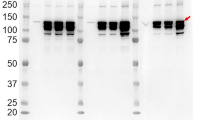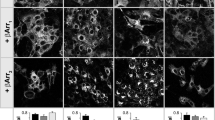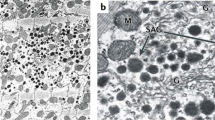Abstract
ATRIAL natriuretic peptide (ANP) is a polypeptide hormone whose effects include the induction of diuresis, natriuresis and vasorelaxation1. One of the earliest events following binding of ANP to receptors on target cells is an increase in cyclic GMP concentration, indicating that this nucleotide might act as a mediator of the physiological effects of the hormone2,3. Guanylate cyclase exists in at least two different molecular forms: a soluble haem-containing enzyme consisting of two summits4,5 and a non-haem-containing transmembrane protein having a single subunit6. It is the membrane form of guanylate cyclase that is activated following binding of ANP to target cells3,7,8. We report here the isolation, sequence and expression of a complementary DNA clone encoding the membrane form of guanylate cyclase from rat brain. Transfec-tion of this cDNA into cultured mammalian cells results in expression of guanylate cyclase activity and ANP-binding activity. The ANP receptor/guanylate cyclase represents a new class of mammalian cell-surface receptors which contain an extracellular ligand-binding domain and an intracellular guanylate cyclase catalytic domain.
This is a preview of subscription content, access via your institution
Access options
Subscribe to this journal
Receive 51 print issues and online access
$199.00 per year
only $3.90 per issue
Buy this article
- Purchase on Springer Link
- Instant access to full article PDF
Prices may be subject to local taxes which are calculated during checkout
Similar content being viewed by others
References
Flynn, T. G & Davies, P. L. Biochem. J. 232, 313–321 (1985).
Hamet, P. et al. Biochem. biophys. Res. Commun. 123, 515–527 (1984).
Waldman, S. A., Rapoport, R. M. & Murad, F. J. biol. Chem. 259, 14332–14334 (1984).
Gerzer, R., Bohme, E., Hoffman, F. & Schultz, G. FEBS Lett. 132, 71–74 (1981).
Kamisaki, Y. et al. J. biol. Chem. 261, 7236–7241 (1986).
Singh, S. et al. Nature 334, 708–712 (1988).
Tremblay, J. et al. FEBS Lett. 181, 17–22 (1985).
Winquist, R. J. et al. Proc. natn. Acad. Sci. U.S.A. 81, 7661–7664 (1984).
Von Heijne, G. Eur. J. Biochem. 133, 17–21 (1983).
Radany, E. W., Gerzer, R. & Garbers, D.L. J. biol. Chem. 258, 8346–8351 (1983).
Ramarao, C. S. & Garbers, D. L. J. biol. Chem. 263, 1524–1529 (1988).
Kuno, T. et al. J. biol. Chem. 261, 5817–5823 (1986).
Paul, A. K., Marala, R. B., Jaiswal, R. K. & Sharma, R. K. Science 235, 1224–1226 (1987).
Maack, T. et al. Science 238, 675–678 (1987).
Leitman, D. C. et al. J. biol. Chem. 263, 3720–3728 (1988).
Fuller, F. et al. J. biol. Chem. 263, 9395–9401 (1988).
Yarden, Y. et al. Nature 323, 226–232 (1986).
Hanks, S. K., Quinn, A. M. & Hunter, T. Science 241, 42–53 (1988).
Koesling, D. et al. FEBS Lett 239, 29–34 (1988).
Kataoka, T., Broek, D. & Wigler, M. Cell 43, 493–505 (1985).
Kozak, M. Nucleic Acids Res. 12, 3873–3893 (1984).
Mueller, P. P. & Hinnebusch, A. G. Cell 45, 201–207 (1986).
Yip, C. C., Laing, L. D. & Flynn, T. G. J. biol. Chem. 260, 8229–8232 (1985).
Takayanagi, R. et al. J. biol. Chem. 262, 12104–12113 (1987).
Shimomura, H., Dangott, L. J. & Garbers, D.L. J. biol. Chem. 261, 15778–15782 (1986).
Hansbrough, J. R. & Garbers, D. L. J. biol. Chem. 256, 1447–1452 (1981).
Bentley, J. K., Tubb, D. J. & Garbers, D. L. J. biol. Chem. 261, 14859–14862 (1986).
Cullen, B. R. Meth. Enzym. 152, 684–704 (1987).
Laemmli, U. K. Nature 227, 680–685 (1970).
Ullrich, A. et al. Nature 309, 418–425 (1984).
Author information
Authors and Affiliations
Rights and permissions
About this article
Cite this article
Chinkers, M., Garbers, D., Chang, MS. et al. A membrane form of guanylate cyclase is an atrial natriuretic peptide receptor. Nature 338, 78–83 (1989). https://doi.org/10.1038/338078a0
Received:
Accepted:
Issue Date:
DOI: https://doi.org/10.1038/338078a0
This article is cited by
-
An Arabidopsis Pentatricopeptide Repeat Is a Moonlighting Protein with Cross-talking In Vitro Adenylyl Cyclase and Kinase Activities
Plant Molecular Biology Reporter (2024)
-
Synergistic effects of hormones on structural and functional maturation of cardiomyocytes and implications for heart regeneration
Cellular and Molecular Life Sciences (2023)
-
Purification, characterization, and preliminary serial crystallography diffraction advances structure determination of full-length human particulate guanylyl cyclase A receptor
Scientific Reports (2022)
-
Therapeutic hypothermia after cardiac arrest increases the plasma level of B-type natriuretic peptide
Scientific Reports (2020)
-
Molecular pharmacology of metabotropic receptors targeted by neuropsychiatric drugs
Nature Structural & Molecular Biology (2019)
Comments
By submitting a comment you agree to abide by our Terms and Community Guidelines. If you find something abusive or that does not comply with our terms or guidelines please flag it as inappropriate.



